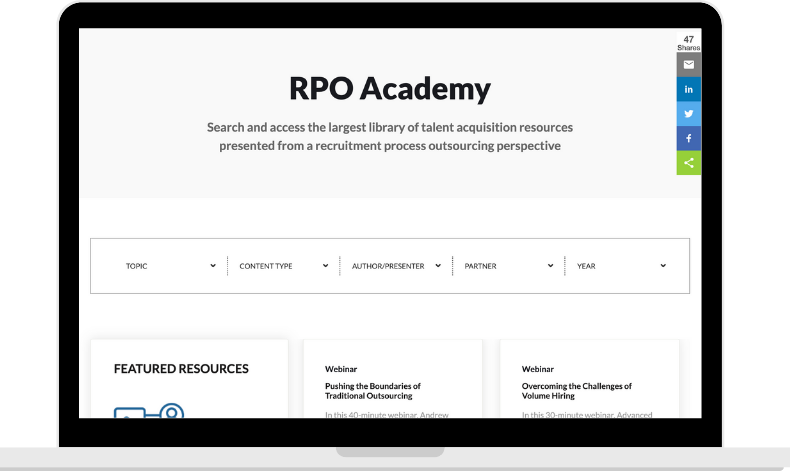-min.jpg?width=800&height=533&name=iStock-1201798767%20(1)-min.jpg)
The global market, valued at $7.3 billion in 2022, projects 16.1 percent growth through 2030. Enterprise RPO dominates with 69 percent market share, while healthcare leads sector growth at 18 percent.1 These numbers reflect fundamental shifts in how organizations approach talent acquisition.
"The recruitment landscape for 2024 has experienced its challenges," Sherry Hamilton, an experienced global talent leader, explained. "Economic constraints, fluctuating hiring needs, and technological advancement have led to what appears to be a recalibration in 2025." This shift drives organizations to seek RPO services. They want scalability, flexibility, and simpler processes.
As organizations navigate these market dynamics, procurement and talent acquisition leaders seek proven approaches to achieve RPO recruitment success. A recent RPOA Expert Panel brought together leaders from both disciplines to share their strategies. The panel, moderated by Sherry Hamilton, featured Chief Procurement Officer Michael Stringer and Global Talent Strategist Gloria MacLennan.
Recommended Webinar: Talent and Procurment Strategies for Recruitment Process Outsourcing Solutions
Process Simplification and Integration
The intersection of procurement and talent acquisition creates opportunities for process improvement. "What I'm consistently hearing from business leaders emphasizes simplification," Stringer explained. "Organizations want RPO solutions to simplify their businesses, and this proves crucial because every organization's processes could benefit from enhancement."
MacLennan approached this transformation from the talent perspective: "We need to approach simplification with an agile mindset. How do we work better? How do we work faster? How do we streamline these processes?" This dual focus on procurement efficiency and talent acquisition effectiveness shapes how organizations evaluate RPO providers.
While process simplification forms the foundation, technology integration presents both opportunities and challenges for RPO service delivery.
Technology and The Human Touch
Organizations integrate artificial intelligence across functions, from HR to finance and legal. "Every organization explores AI integration," Stringer noted. "However, technology serves to enhance rather than replace the human element."
Hamilton emphasized specific considerations for technology implementation. Organizations need controls against bias in recruitment processes, transparent data for decision-making, and technology that supports global talent acquisition needs. These elements work together to create effective recruitment solutions while breaking down barriers across organizations.
MacLennan outlined specific criteria for evaluating RPO technology: "I want to understand what their tech stack looks like. What improvements will they make? How will they build that people strategy?" When procurement teams and talent leaders collaborate on technology assessment, organizations select tools that serve both operational efficiency and candidate experience goals.
Technology selection represents one aspect of successful RPO services. The panel emphasized how strong relationships and regular communication drive long-term success.
Creating Collaborative Partnerships
RPO services succeed when procurement, talent acquisition, and providers trust each other. "Culture and business goals," MacLennan said, "shape the candidate experience." Whether managing recruitment internally or through RPO, all components work together."
MacLennan elaborated on how this collaboration affects employer branding:
Stringer stressed the need for regular strategic alignment. "You should meet at least annually to review how your RPO services align with business goals." Where is your HR strategy headed? What does your technology roadmap look like?" These discussions prevent misalignment between procurement goals and talent acquisition needs.
Recommended Article: Understand The Advantage of Using RPO to Implement Recruitment Marketing
Adapting to Market Changes
Economic conditions force organizations to change their business models. This raises new demands for RPO services. "One day they make widgets. Then, that business slows. Suddenly, they need to course-correct and develop new products," MacLennan noted. This reality requires procurement and talent teams to select providers who demonstrate adaptability.
The wind energy sector exemplifies these challenges. "This field requires technical experts, engineers, and offshore specialists," MacLennan explained. "The challenge extends beyond finding people - we need people with skills that the market has not yet developed." This example shows how procurement and talent teams must work together to address emerging industry needs.
Market changes require organizations to develop specific strategies for managing service transitions.
Managing RPO Transitions
The panel examined how organizations navigate changes in RPO service delivery. MacLennan noted, "Businesses change their models frequently. RPO providers must adjust their approach accordingly." These shifts require coordination between procurement and talent acquisition teams to maintain service continuity.
Stringer emphasized the global perspective: "Managing global transitions requires strategic planning and constant assessment." This planning ensures service quality remains consistent during organizational changes.
Successful transitions depend on clear performance measurement and analysis.
Data and Analytics in RPO Services
Effective RPO services provide procurement and talent leaders with actionable insights. "When operating globally, having transparent data helps you understand what's happening around the world with your workforce," Stringer explained. He emphasized the need to track success rates and understand performance across regions.
MacLennan connected analytics to operational improvements: "The data piece drives everything we've discussed. What can the RPO provider show us? How frequently will we meet to discuss these analytics?" Regular review of these metrics helps organizations adjust their approach based on actual performance.
Stringer noted that timing plays a crucial role in data analysis. Organizations need regular checkpoints to assess service delivery and make informed decisions about necessary adjustments. This approach helps prevent issues before they affect recruitment success.
These insights about data and analytics inform how organizations prepare for future RPO service needs.
Future-Ready Implementation
Organizations preparing for 2025 need RPO services that combine process improvements, technology integration, and data analysis. Hamilton emphasized selecting providers based on their ability to transform recruitment processes, adapt to business changes, and maintain human connections while delivering measurable results.
"We're in the midst of another evolution in talent," MacLennan explained. "How we engage with candidates continues to change." This evolution demands flexible RPO solutions that adapt to emerging requirements while maintaining operational efficiency.
As Hamilton concluded, success depends on maintaining flexibility in RPO relationships, aligning solutions with business needs, using data effectively, and fostering strong connections between procurement, talent acquisition, and RPO providers.
We encourage you to visit the RPO Academy to learn more about gaining recruitment success.
Reference: [1] Grandview Research














